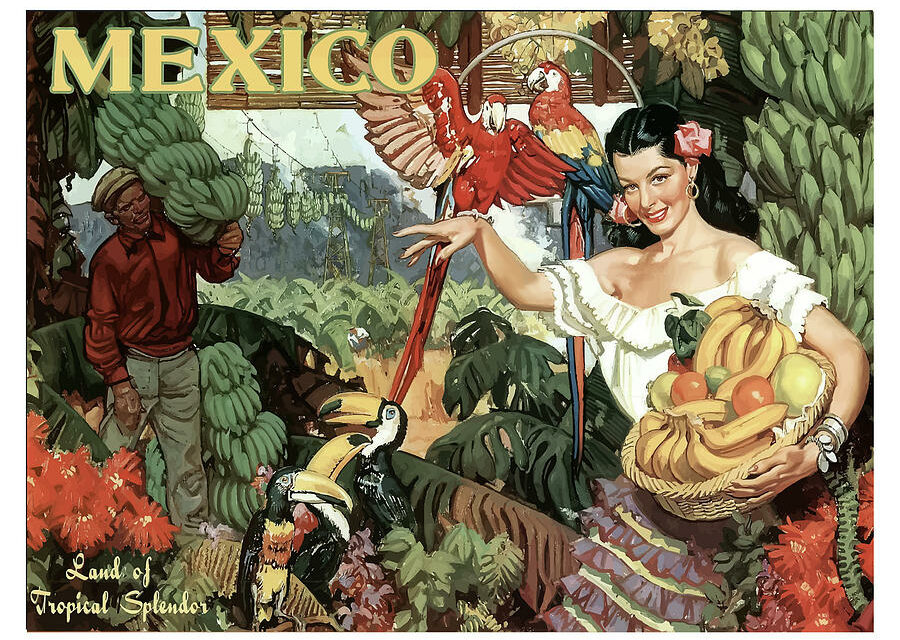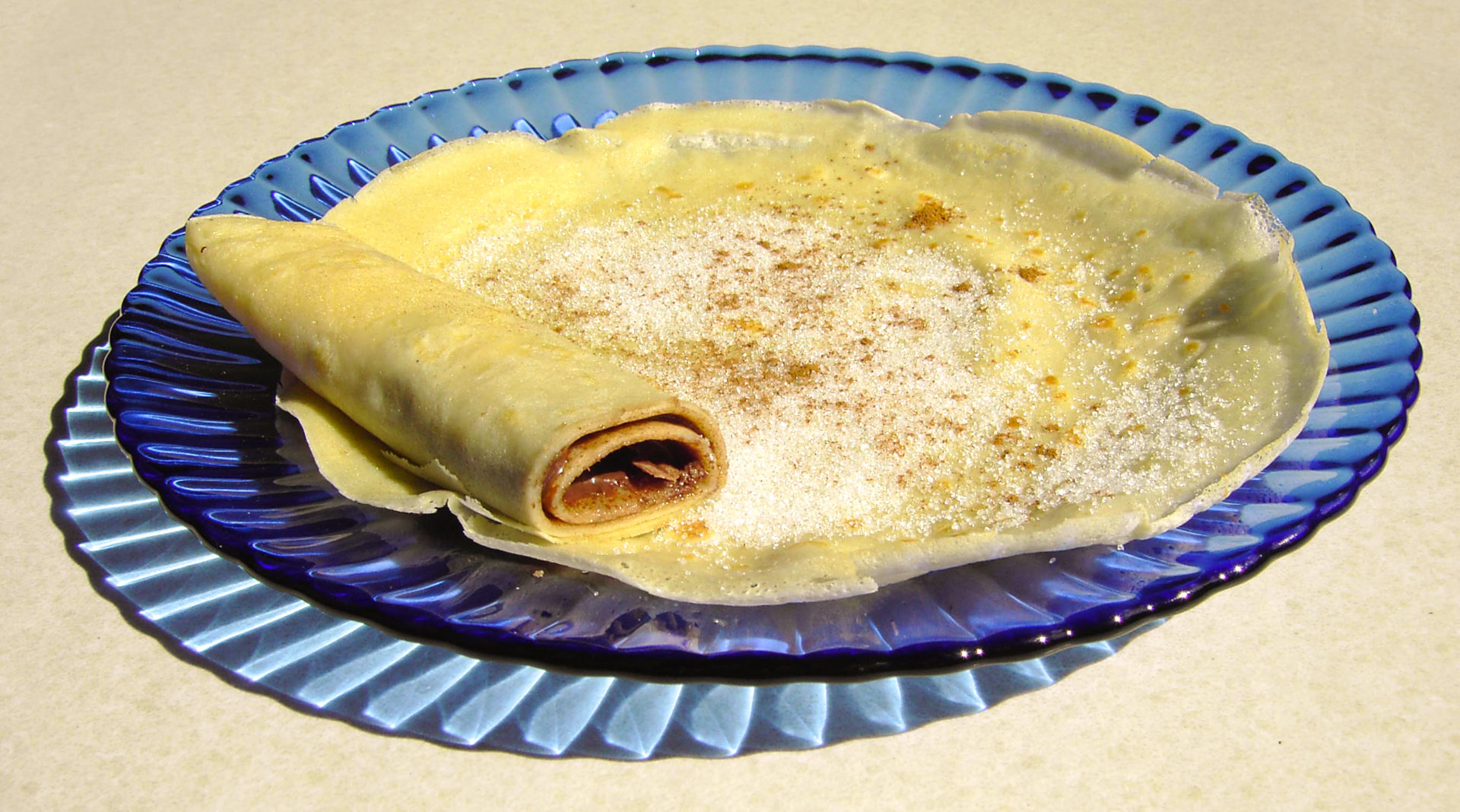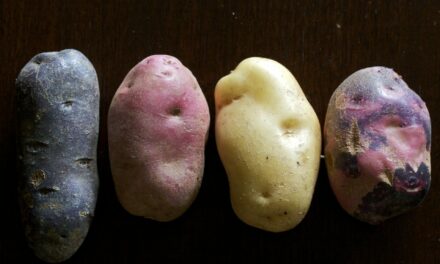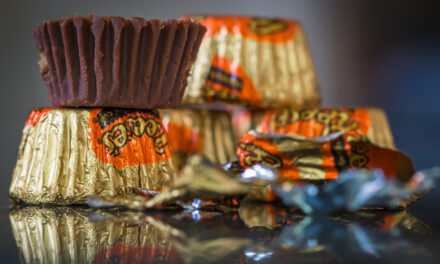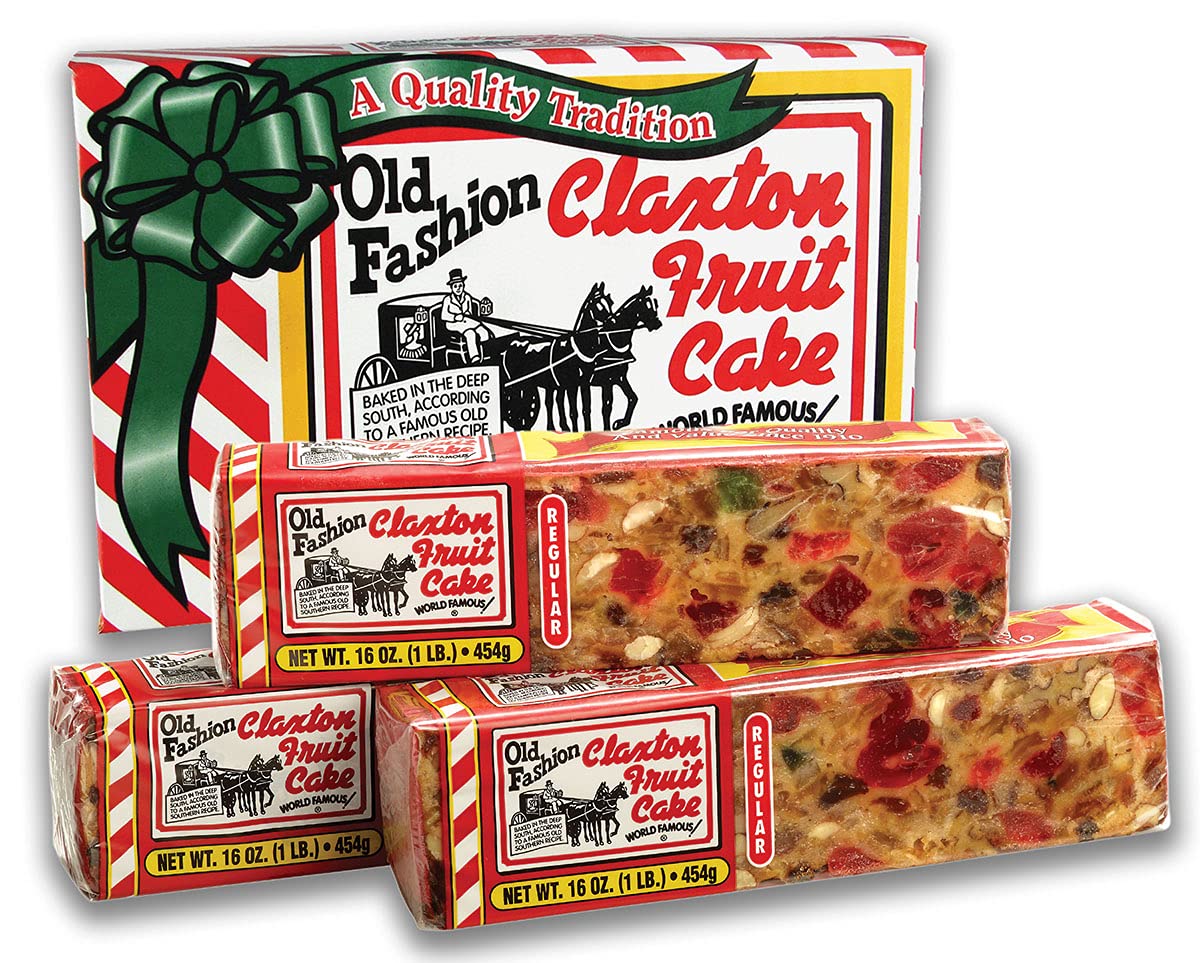Vintage Tourism Poster, Mexico
A Century or More of Banana Scandals
A few years ago, an unusual sculpture at the famous Basel art fair made headlines and raised a few eyebrows. The work by Italian artist Maurizio Cattelan was called Comedian, but came to be known as the Basel banana. It was a ripe banana, duct-taped to the wall.
Patrons must have been hungry. All three editions sold out, at $120 000 a pop.
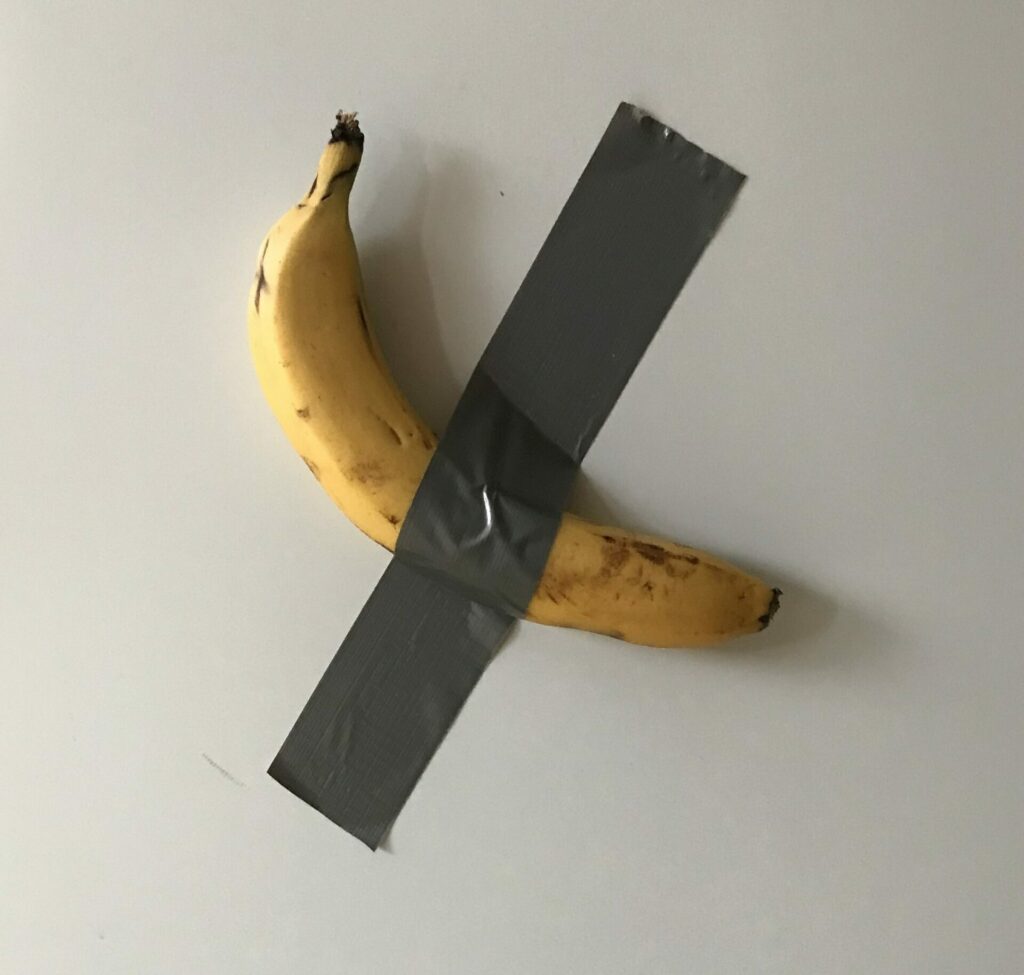
Not THAT Duct Tape Banana, but a Reasonable Facsimilie….Banana Duct Taped to Fridge, photo by Jane023, CC0 1.0 Universal (CC0 1.0)
Another wacky contemporary art darling, Damien Hirst, best known for sliced up taxidermy in formaldehyde and Plexiglas sculptures, tried to trade some of his own work for the still-life with duct-tape phenomenon.
If the whole thing sounded like a bad joke, and an expensive one, you’re getting warmer. Cattelan’s satirical, anti-art artworks make a mockery of everything from the art market to rich consumers to Donald Trump. Another famous sculpture was America, a solid gold functional toilet placed for use inside the public bathroom of the Guggenheim Museum.
Nor was it the first time that banana art caused such a scandal.
It was almost one hundred years ago that African-American showgirl Josephine Baker sashayed down from a jungle canopy onto a Paris stage, wearing precious little other than a skirt of rubber bananas. It was a hideously racist theatrical premise, with an equally racist name, the “danse sauvage.”
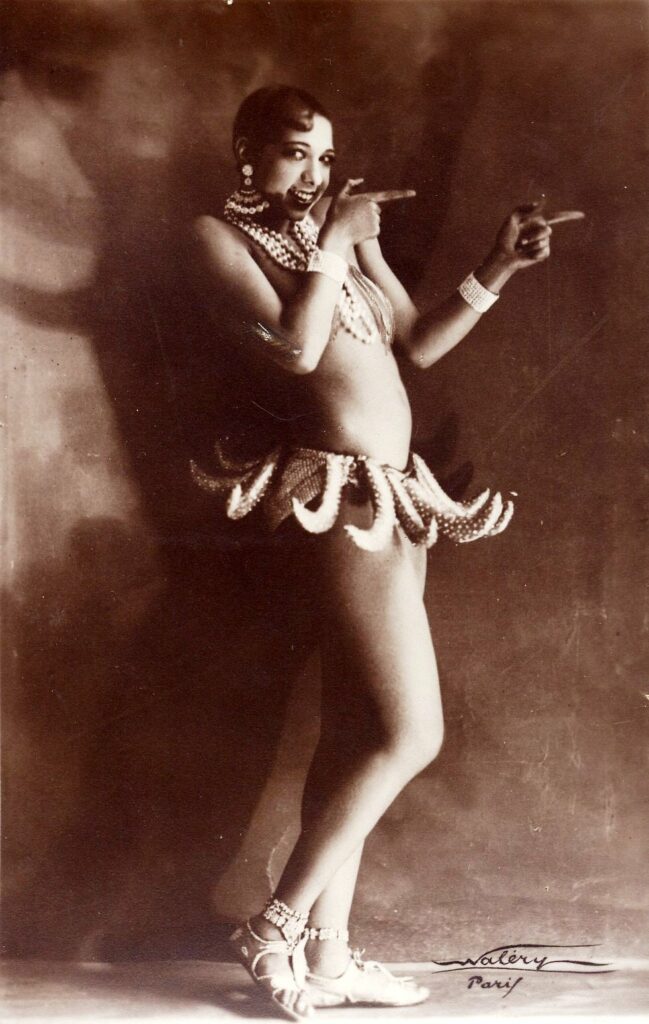
Josephine Baker in Banana Skirt, photo by Lucien Waléry, 1927, Public domain, via Wikimedia Commons
But Ms. Baker was a sensational beauty and a spectacular dancer, and possessed a freedom and confidence in her own body and moving it in ways that gave a giant middle finger to everyone still trapped in their stuffy stereotypes and cloying propriety. She was also a comedic genius and a century later, her performance reads like a satire of minstrel theatre and of racism in general. In a few moments of lightning speed choreography of wiggling and jiggling, the dirt poor exotic dancer from St. Louis who used to sleep in a dog’s bed on the floor became the first Black superstar. She 21 years old. The banana scandal torpedoed her into the limelight and she went on to become a movie actress, singer, diva, civil rights heroine, adoptive mother to twelve, and even a spy. The banana dance was a seminal moment in cultural history. Josephine Baker had essentially turned the tables with her outrageous gorgeous twisting and twerking. The audience was not laughing at her. She was laughing at us.
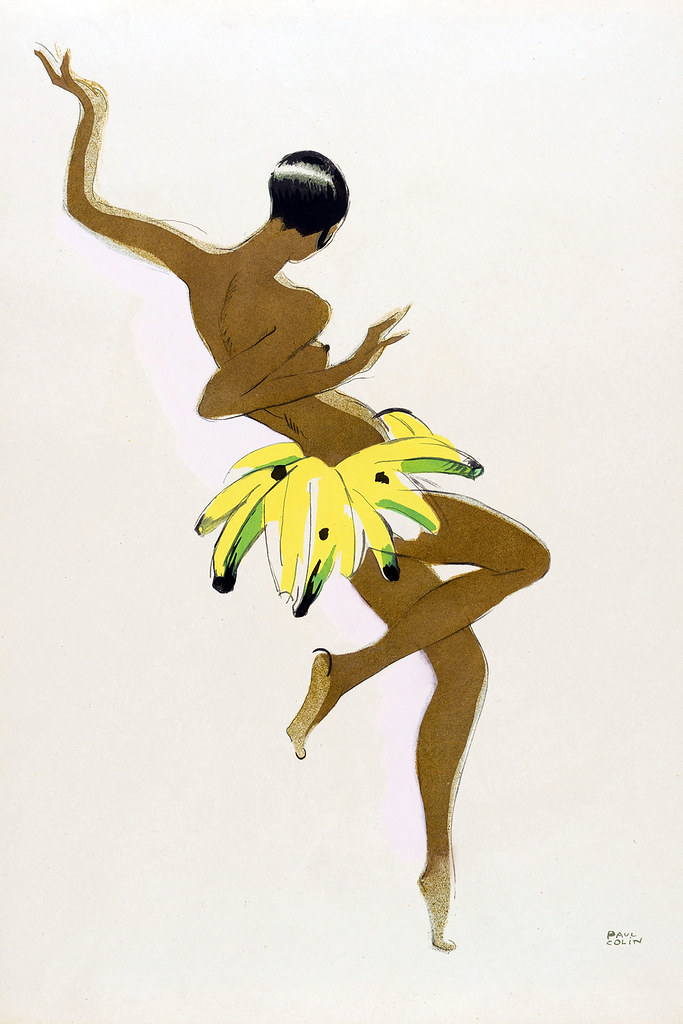
Le Tumulte Noir, 1927, art by Paul Colin, CC BY-SA 4.0 via Wikimedia Commons
A now iconic banana made history in 1967, too, on the cover of the debut album by The Velvet Underground and Nico. Pop artist Andy Warhol was busy in his screen-printing factory, creating works of common consumer objects. It was a few years after his soup series. A simple, single banana was slapped onto the cover of the first recording by his pet rock band. Warhol was also listed as the producer, mostly because he funded the project.
The album was gritty, even sleazy, voicing the raw poetry of the hedonist underworld, referencing everything from drugs to sadomasochism. Today we revere The Velvet Underground as art rock, and Lou Reed, the poet at its helm, as a prophet, but in its day it was a kind of shock rock. Audiences were still largely used to shine and bop and this was one of the albums that signified a massive cultural shift to the era of “sex and drugs and rock’n’roll.” Far from mindless glorification, Reed was an English major and saw himself as a writer of his generation. Inspired by Raymond Chandler, William S. Burroughs, and others, he believed you could use music to tell truthful stories about real human struggles. The song “Heroin” is of course now a classic, a spellbinding love song that masterfully builds tension, then floats into bliss, mimicking the experience given by its subject. Then it scatters into a terrible and painful dissonance, as honest a story as there ever was, a song that can only be described as a “dirge.”
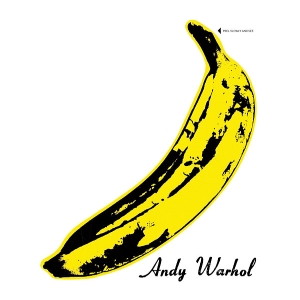
Velvet Underground and Nico, album cover by Andy Warhol.
The banana art was, of course, a middle finger of its own, an innocuous and everyday sundry on its own that also happens to be a potent phallic symbol. Lest anyone doubt the intention of the artist, the original album pressings featured an interactive peelable cover art that rolled back to show off a pink-fleshed banana fruit underneath.
The banana is a longstanding phallic or virility symbol, of course, recurring frequently in art and literature, before Josephine and after Warhol. The banana emoji is commonly used today in text messaging as a not so secret code. Likewise, in the sly entendre traditions of blues music, it was a not so subtle symbol in 1934 when Memphis Minnie belted out Banana Man Blues, “Oh what that man selling over yonder? Bananas? Show me! Yes, I want that thing, yes, I want that thing…”
Interestingly, bananas have been an essential symbol of female fertility and abundance for even longer. In the world’s oldest religion, Hinduism, banana trees are strategically placed on either side of the home entrance during a wedding. Durga, a major Hindu goddess of war and motherhood is associated with the tiger, and the banana tree! Effigies of Goddess Durga are made with banana leaves, and she is called Kola Bou, or “Banana Lady.”
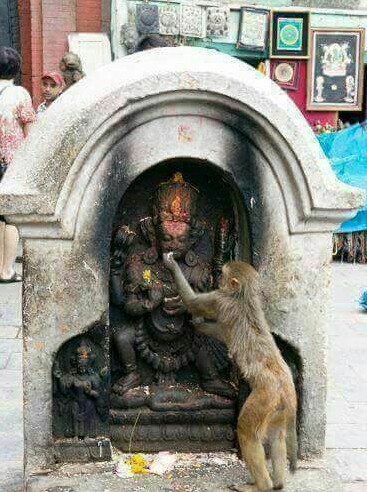
Monkey Feeding Bananas to Goddess Durga, Nanthesh, CC BY-SA 4.0via Wikimedia Commons
Bananas are also symbols as figures of speech for “eager and enthusiastic” and also for “crazy.” We use the words “going bananas” to mean someone acting unusual or odd in an eager way. They might be a little nutty (another vague food analogy of “mad”) over a love interest, as in Madonna’s fun Dick Tracy soundtrack song, “I’m Going Bananas.”
There are numerous theories of how this phrase came to signify “going crazy.” “Bananas” was once a euphemism for someone with strange sexual proclivities. “Banana oil” was briefly used in the Jazz Age along with snake oil to mean “nonsense.” It is possibly quite simply evolved from the apes- “going ape” seems to come after “going bananas” but references monkeys going wild for a bunch of bananas or other goodies.
More recently, banana has been used as an insult or slur against Asian-Americans who supposedly aren’t acting closely enough in accordance with their heritage. (A parallel is “Oreo,” the insult for African-Americans who are accused of looking brown while being “white on the inside.”)
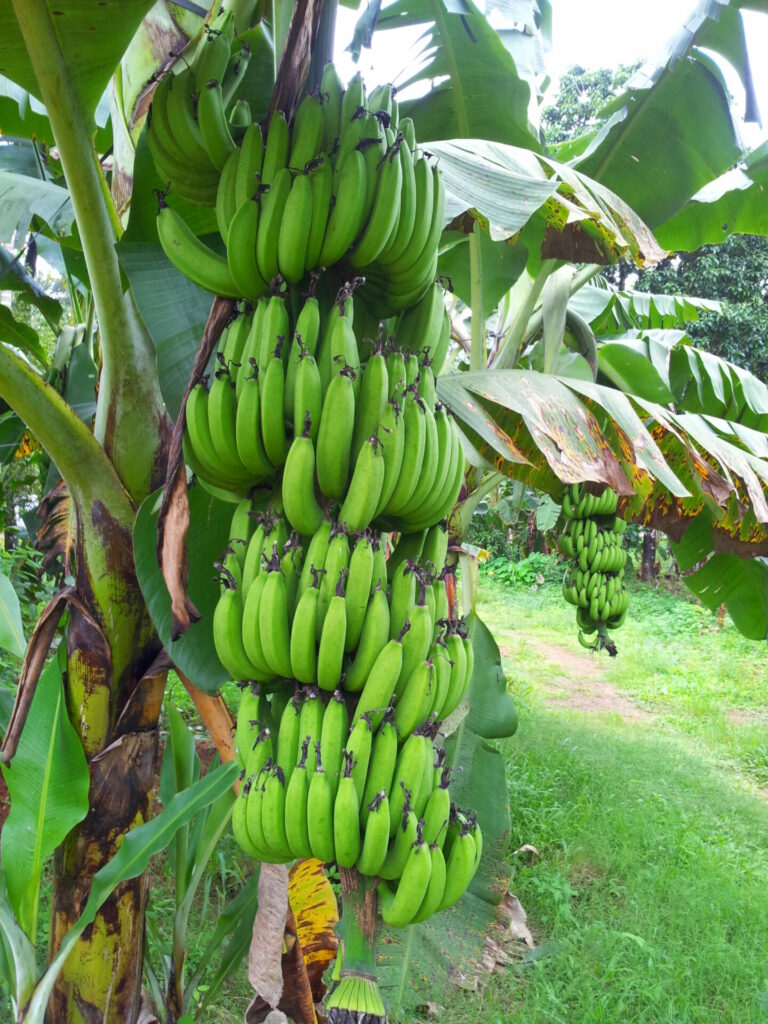
Banana tree from Valiyaparambu, Kerala Rameshng, CC BY-SA 3.0 via Wikimedia Commons
Finally, bananas have been used to represent colonial consumerism in literature, music, and more.
Bananas are a tropical fruit with enthusiastic growers anywhere it’s hot. (It is likely that the word comes from the west African Wolof language, “banaana.”) While the first domesticated bananas have been traced so far to around 8000 BC in the South Pacific islands, they made their way rapidly to India, Africa and Asia with seafarers shortly after that. More recently, in the age of speedy steam and refrigeration, they landed everywhere else. With a creamy, pudding-like texture and the mild, vanilla-like flavour, bananas don’t taste like anything else. They have a world-wide enthusiastic audience, loved anywhere they’re tasted. (Around 85% of people like bananas, with more than half saying they love them. Only a few people dislike or hate bananas, although most have a strong preference for level of ripeness.) They are the most popular fruit on the planet, with more than 100 billion consumed each year according to National Geographic.
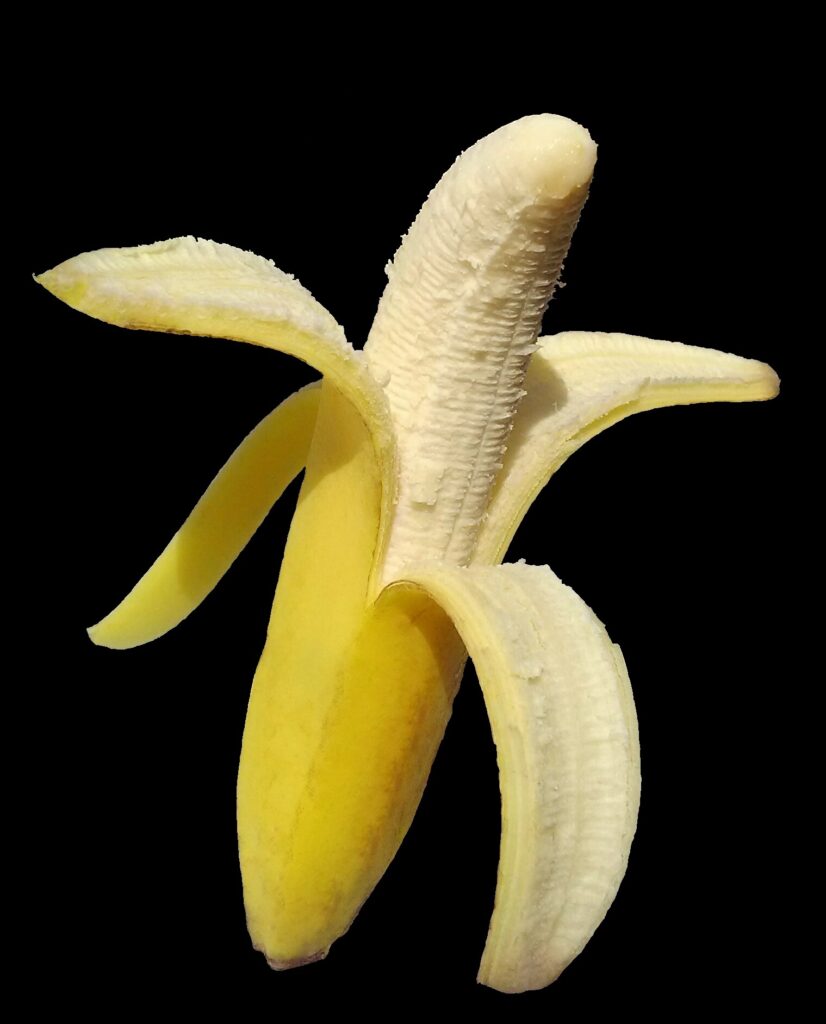
Banana, Filo gèn’, CC BY-SA 4.0 via Wikimedia Commons
Many foodstuffs have long and rocky histories of theft and borrowing, contesting origin stories, and outright slavery, paralleling exploration, migration, war, and colonization patterns of human societies everywhere, bananas’ have quite recently left this bitter taste in the mouth. Issues like government corruption, wage slavery, environmental degradation, and child labour persist in the banana industry to this day. (Learn more at Food is Power, here.)
In William Faulkner’s 1930 novel, As I Lay Dying, bananas were an important symbol of the conflicts and problems inherent in corporate banana trading. The banana was an affordable new food for poor Americans after the invention of refrigeration transport that slowed ripening. But what was the cost? The United Fruit Company (today, Chiquita Bananas) was a massive American corporation that wreaked havoc in South and Central American countries, drowning small local suppliers and swallowing up land and profits for itself while using local labour dirt cheap.
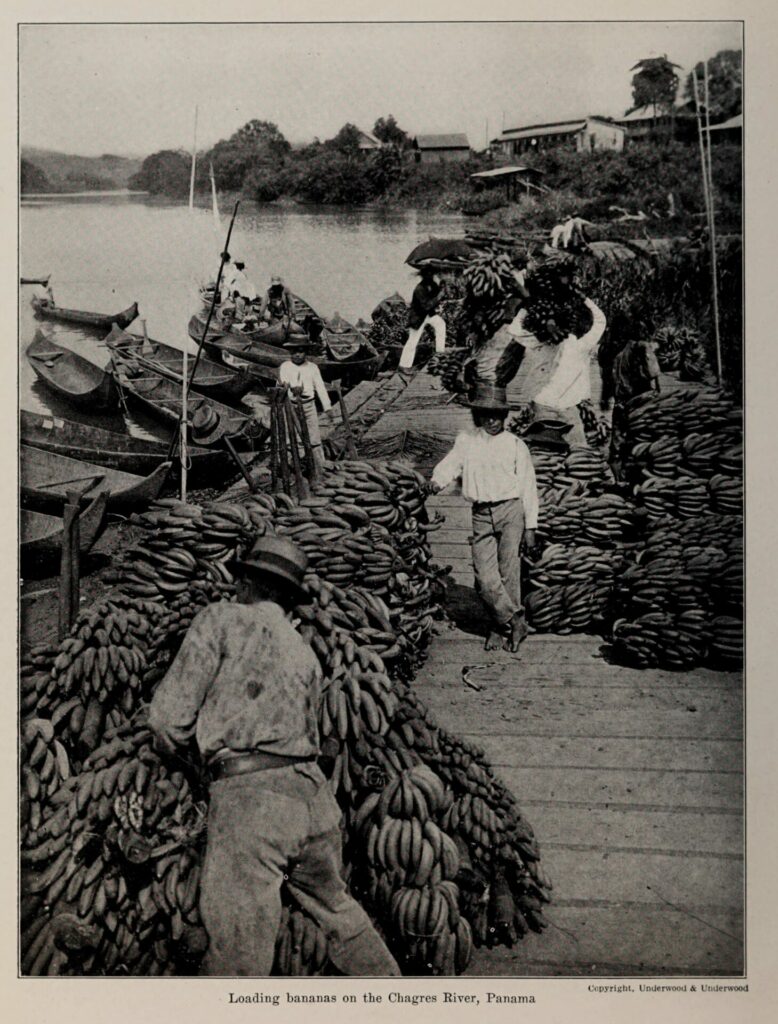
Loading Bananas on the Changres River, Panama, Artemas Ward, Public domain, via Wikimedia Commons
In bed with corrupt local governments, the United Fruit Company and other multinational corporations leveraged the power of the US government against smaller countries. It started in 1870, buying bananas cheap in Jamaica and selling them in New England at profits 1000 times higher. The writer O. Henry coined the term “banana republic” in 1904 in his short story collection, Cabbages and Kings, a phrase that means corrupt governments that sell out their people to the highest bidders. In 1928, United Fruit Company workers in Colombia protested their conditions and asked for a six day work week and compensation for work-related accidents. The Colombian Army raided the strike on behalf of the corporation, in what has become known as The Banana Massacre.
Then there was the ‘70s Bananagate, when the United Brands president jumped out of his office window. Investigators found he was tangled up in a plan to bribe the president of Honduras to lower export tariffs. This kind of thing was literally a dime a dozen throughout bananalands exporting to American markets.
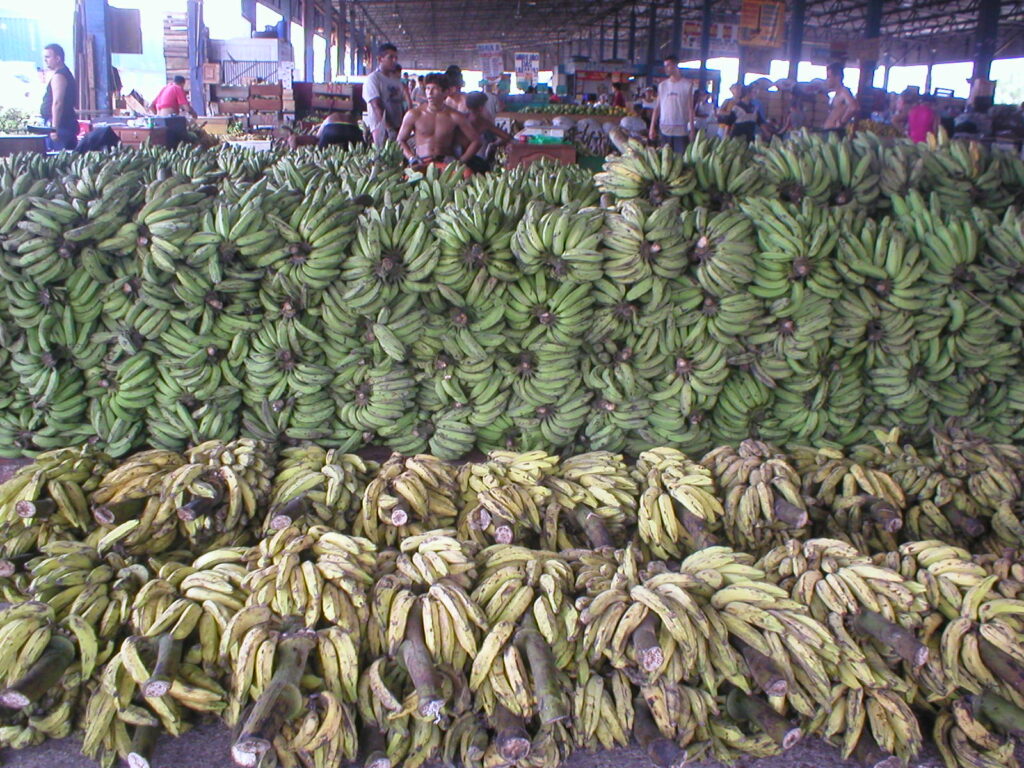
Market in Manaus, Brazil photo by eltpics (CC BY-NC 2.0) via Flickr
Harry Belafonte’s hit song “Day-O (The Banana Boat Song)” was a 1956 recorded version of a traditional Jamaican calypso folk song sung by dock workers loading banana boats. It addressed some of the problems of cruel labour practices in the banana trade. “Come Mister tally man, tally me banana…daylight come and wanna go home,” goes the refrain. Belafonte described it as “a song about struggle, about Black people in a colonized life doing the most grueling work.” While Belanfonte’s song has an infectious melody and chorus, it is in fact a protest song of sorts.
Belafonte was a beloved singer and civil rights activist. But an even more famous rendition of his “Day-O Banana Boat Song” was by none other than our current prime minister and leader of the Liberal Party of Canada, Justin Trudeau. On one of the many occasions that he dressed up in blackface, one was with an Afro wig to perform Belafonte’s “Day-O.” Trudeau admitted that he couldn’t tell us how many times he’d blacked up, not just as a high school student but also as an adult teacher. However, he apologized and asked our forgiveness. Whether this was true contrition or the ultimate in privilege, he won the next election following this banana scandal. And what can I say? I dressed up as my idol Michael Jackson for a Halloween party when I was 13 years old. Now we know better.
With all these scandalous and sinister bananas, not to mention banana massacres, you might be wondering whether you should ever enjoy the sweet and sunny yellow fruit.
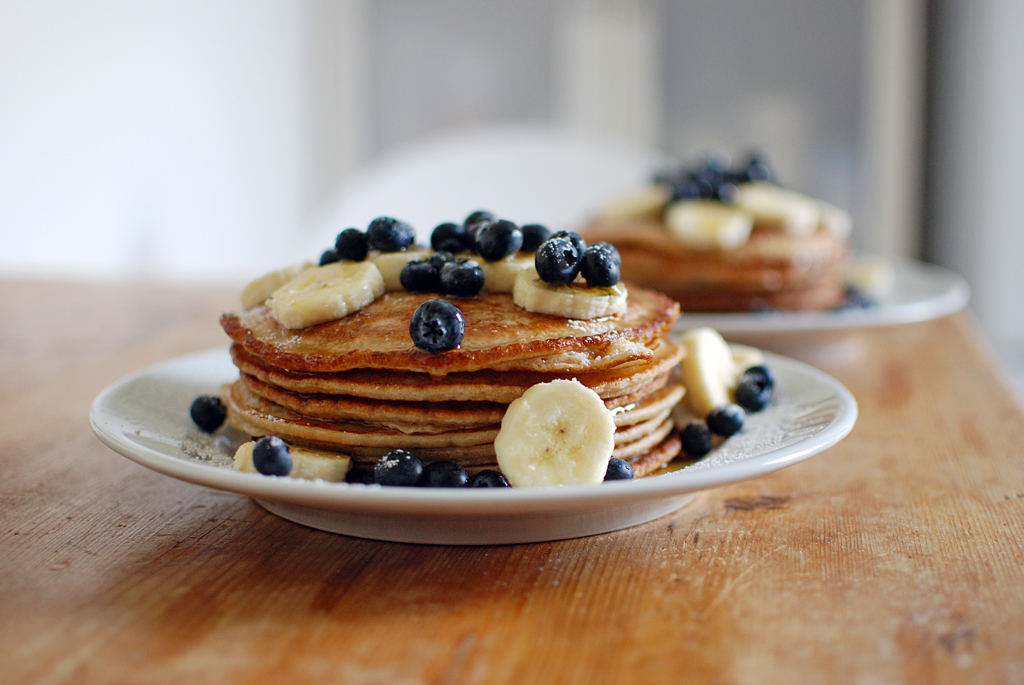
Pancakes, photo by Nicola Holtkamp via Flickr (CC BY-NC-ND 2.0)
Yes! Forgoing banana pancakes is no way live. Even if you are carb-conscious, you need an occasional fix. This sugary treat comes with a mild dose of numerous nutrients, helping you stack your vitamins and minerals at the end of the day. Notably, bananas contain magnesium and potassium, which aren’t always easy to get. They have a lot of B, too. And while you can get all of this elsewhere, you can’t substitute anything for the flavour of a banana. There is no other food that is similar. Both the texture and the flavour are in a league of their own. Arguably, they can’t be replicated at all, as everyone who has ever tried a “banana flavoured” anything knows. Banana things that don’t contain bananas are terrible!
What you can do is get fair trade bananas. Considering how inexpensive these beauties are, spending a bit more and being conscientious about using up what you have won’t cost much extra. It may seem too simple, or it may seem annoying to source, depending where you live or shop. But fair trade banana buying is a way you can really make a concrete difference in the world. There are companies that are proven to pay a living wage, reject child labour, and avoid toxins that affect your health and the health of workers, as well as the environment. It’s a worthwhile investment of time to spend a few minutes researching fair trade banana companies. A great company is Equifruit, and you can find them at Longo’s and at Farm Boy, but there are others.
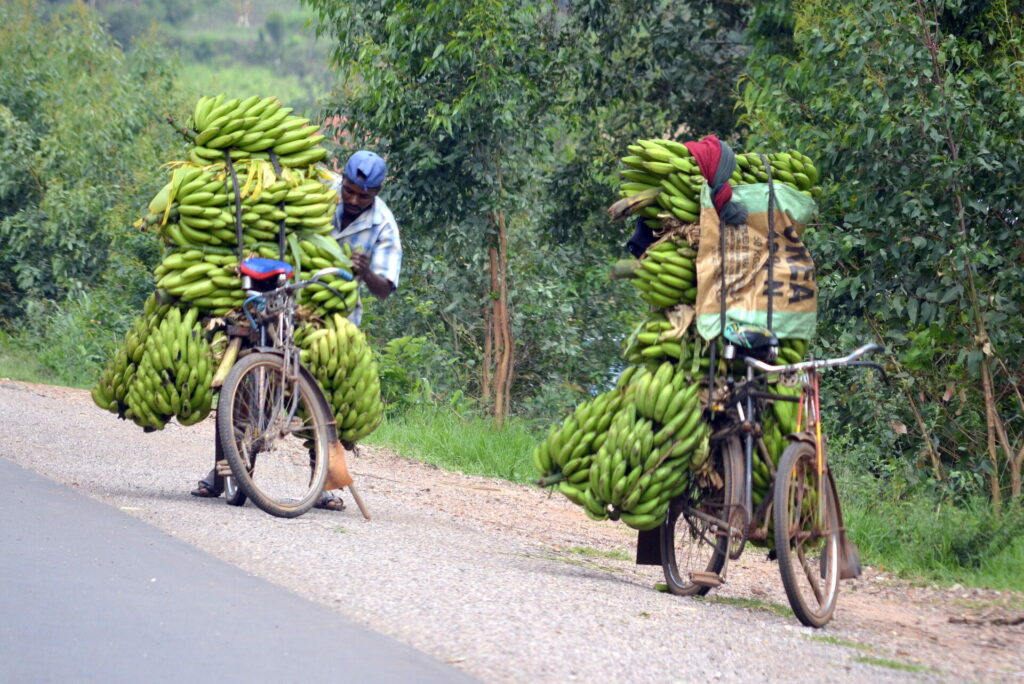
Balancing Bananas in Rwanda, photo by Gwendolyn Stansbury 2013(CC BY-NC-ND 2.0) via Flickr.
The classic manoeuvre for salvaging too-ripe bananas from the compost heap is the reason there are thousands of banana bread recipes in every North American family and cookbook this past century. While it may feel like this tradition goes way back, it didn’t come with Oma to Canada but rather came to her from Nicaragua or Colombia. Once those bananas started rolling north in refrigerated trains and boats, banana bread recipes started to abound. Bananas were precious cargo but most folks prefer them before they turn to mush. What then? Turns out tossing bananas together with a bit of flour and some nuts yielded one of the greatest loaves known to humankind. Everyone loves banana bread, and everyone loves how easy it is to throw together.
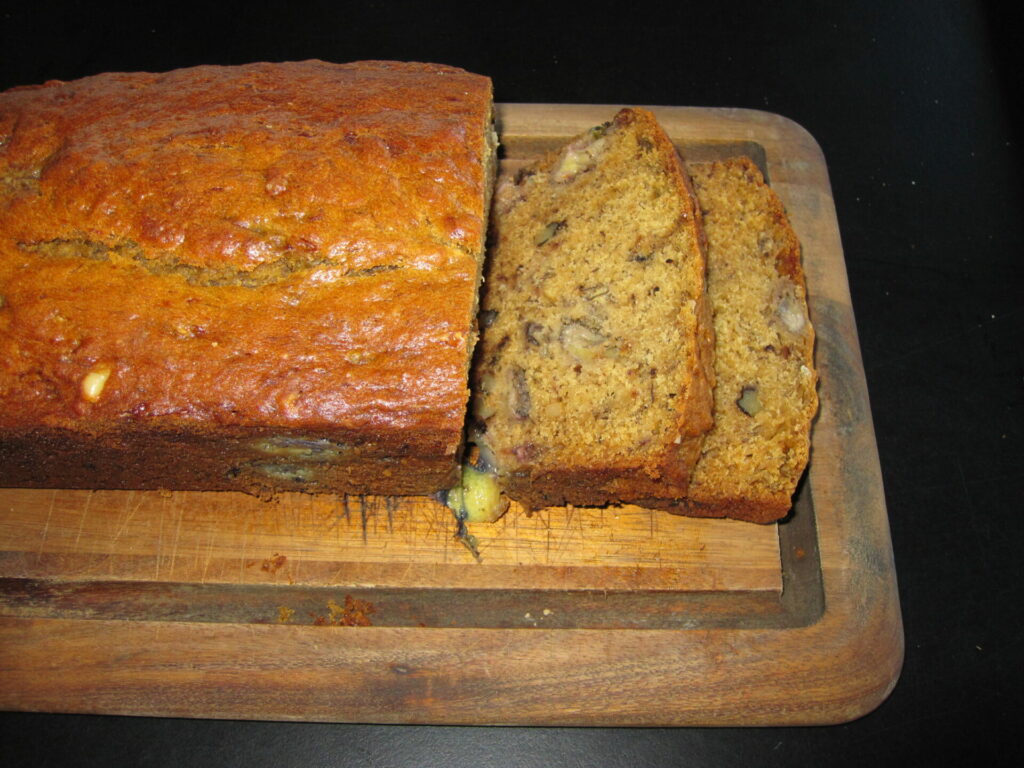
Banana Bread, Karen and Brad Emerson, CC BY 2.0 via Wikimedia Commons
While banana bread as the loaf we know and love is an American invention, the concept, born the same way, has been in full use the world over, from Nigeria to Vietnam to the Philippines. Everywhere you go, there are variations on the theme: banana cakes, banana fritters, banana buns.
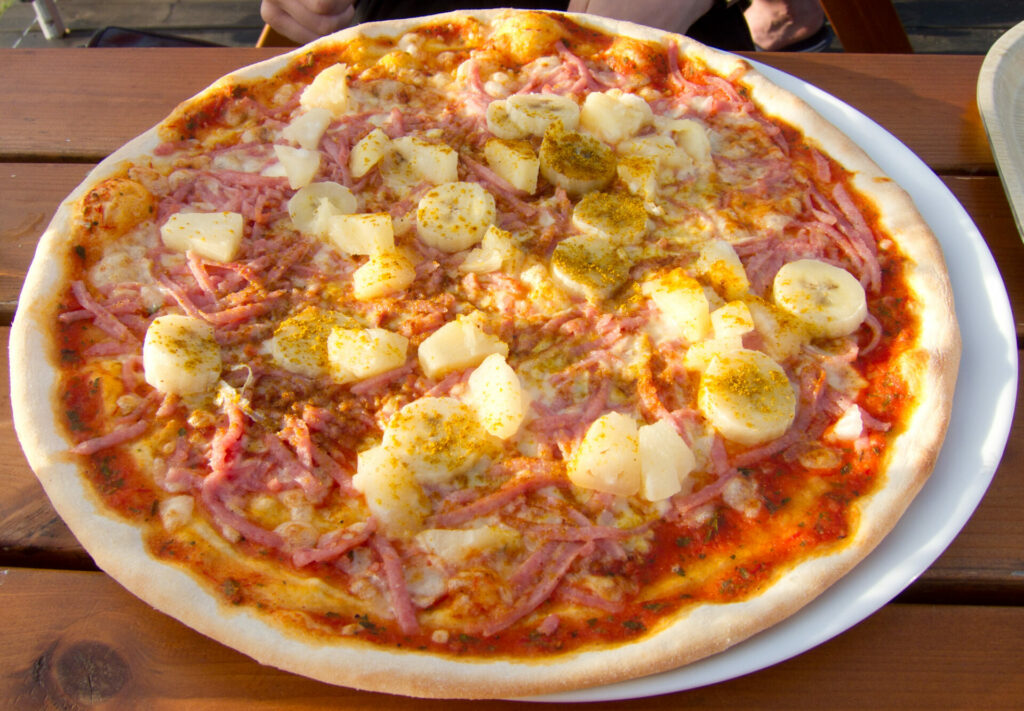
Banana Curry Pizza, photo by Peter Guthrie 2010 (CC BY-NC-ND 2.0)
Only one place, however, puts bananas on pizza. Hold on, what? Yes. As one Tumblr post quipped, “Americans having discourse about pineapple on pizza are so blissfully unaware of the nightmare that is Swedish banana pizza.”
Snopes confirmed it- banana pizza is a thing in Sweden.
In fact, it is even more bananas than that: Banana Curry Pizza.
Word is you can get the stuff at any pizza parlour in the nation.
Now that’s scandalous. And delicious.
Lorette C. Luzajic
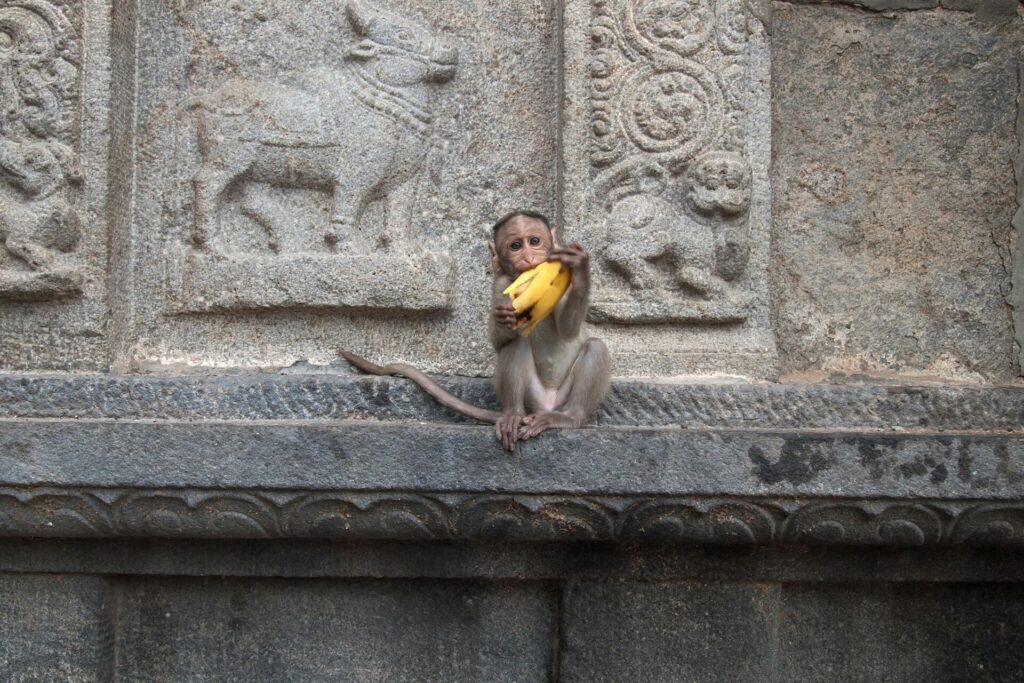
Tiruvannamalai, Baby Monkey Eating Banana, India, © Vyacheslav Argenberg www.vascoplanet.com CC BY 4.0 via Wikimedia Commons

